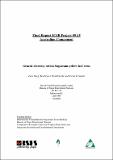| Abstract | Sugarcane yellow leaf virus (SCYLV) is widespread in many sugarcane growing countries of the world. The aim of this study was to determine the extent of genomic variation in SCYLV isolates from various countries. Isolates were obtained from Mauritius, Reunion, South Africa, Australia, Papua New Guinea, Hawaii, U.S.A. and Brazil. Four regions of the SCYLV genome (ORF 1, Replicase, Coat Protein and Readthrough) were analysed for variation using both RFLP analysis and sequence comparisons. Of the fifty isolates used, several did not produce RT-PCR amplicons in one or more of the regions covered, suggesting variation in regions where the primers bind. Of the amplicons produced across the four regions studied, RFLP analysis and sequencing results revealed the Coat Protein (CP) region to be the most conserved, followed by the Replicase (REP) region. These areas should be targeted for diagnosis of SCYLV and for use in viral mediated transgenic resistance in sugarcane varieties. Phylogenetic studies of the nucleotide and protein sequences of the four regions covered were performed using eighteen isolates. Representative isolates from each country were used where possible. In a second round of phylogenetic studies, covering the REP and CP regions, nine isolates from North, South and Central America, sequenced by our American collaborators on this project, were included. Variation in nucleotide and protein sequences revealed that many haplotypes of SCYLV exist across the countries tested. Most isolates from the various countries are very closely related across all four regions. Phylograms produced from REP and CP sequences in Phylogeny study #2 revealed that isolates from Hawaii and Australia tend to group together as do isolates from Mauritius and Reunion. Phylogenetic analyses on the sequences used in this study have not identified any significant variants of SCYLV. In conclusion, we recommend that the YLS111 and 462 RT-PCR primers originally developed by Mike Irey and colleagues continue to be used for routine SCYLV diagnosis. Also, the viral coat protein and replicase regions being the most conserved, should be targeted in research to genetically engineer resistance to SCYLV. |

